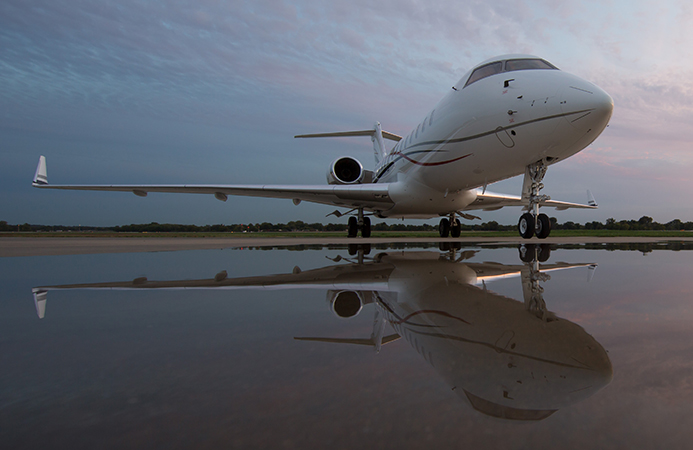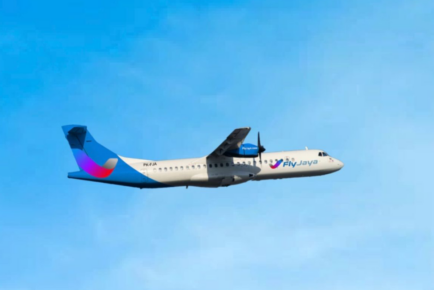
Download article in PDF format
Jetcraft anticipates the growth of the pre-owned market in Asia
April 2013; Executive & VIP Aviation International – Jetcraft has been in the new and pre-owned jet brokering business for some 50 years. Having built up a solid base in the US, with customers in Europe and Latin America and now with business starting to come in from Asia, Jetcraft CEO Chad Anderson is laying plans to capitalise on the inevitable appearance of a pre-owned market in Asia. “Few would dispute that Asia is one of the hottest markets for sales of new long-range/large cabin business aircraft. Our sales figures for 2011 and 2012 more than bear this out. We’ve been selling new and pre-owned into Asia for some time now and while the vast majority of orders are for new jets, about 10% to 20% of what we sell is good pre-owned,” he says.
The major reason driving the pre-owned market at present in Indonesia and Asia generally is not that high net worth individuals have come around to a really positive view of the pre-owned market. New is still regarded as vastly superior. However, the lead times from the major manufacturers are too much for some buyers to tolerate. “As demand picks up after the flat times, we are seeing lead times on large cabin aircraft getting longer and longer. That has been a definite trend in the last 12 months, so if you are interested in the large cabin category pre-owned naturally comes into consideration,” Anderson says. It is simply logical to foresee a vigorous pre-owned market starting up as aircraft warranties start to expire over the next few years. “We see the opportunity as twofold. You can sell new and pre-owned aircraft into the region, but you will also shortly be able to sell pre-owned aircraft from Asia into the global market,” he comments.
There is some slight financial advantage in Far Eastern Jetcraft anticipates the growth of the pre-owned market in Asia 24 Executive & VIP Aviation International April 2013 selling pre-owned back into the China market, since the process and expense that goes with gaining a Chinese registration for a plane can create a small premium on the sales price. However, for the most part, aircraft coming on the market in China are quickly sold into the global client base. China may, within a relatively short timeframe of ten years or so, build its own business jets. The State-owned Commercial Aircraft Corporation, Comac, is said to be developing a regional jet to compete with planes made by Embraer and Bombardier. “The idea of China building its own jet is interesting but you have to allow a fairly extensive timeframe for this. The challenges involved in bringing a new business jet to market and getting it through the certification process are very steep. Succeeding here requires a tremendous amount of time and experience, Anderson says.
So how far off does he think a mid-sized jet market is for China? There is no doubt that mid-sized jets make a lot of sense in some parts of Asia, particularly South East Asia. But the crunch point for mid-sized jets as things currently stand is that if you look at the key routes, none of them are mid-sized jet routes. The distances involved are well outside the range of mid-sized aircraft. “Over time, I am sure it will develop as people want to fly between tertiary and second-tier cities that are not well served by commercial airlines. The obstacles, however, are formidable and they are more severe when you talk about airspace issues than about the lack of ground-based facilities like FBOs at regional airports,” he comments.
Jetcraft started Jetcraft Asia two years ago, headquartered in Hong Kong. The company hired David Dixon, a former Regional Vice-President of Bombardier Business Aircraft and a man with three decades of experience of the Asia market, to be President of its Asia operations. Dixon points out that the main city pairs in China are actually very well served both in terms of quality and frequency of flights, by the mainstream commercial airlines, and since the majority of business inside China is transacted between companies located in the tier one cities, this takes away some of the momentum for companies to buy their own business jets. At the same time the infrastructure for business aviation between tier one and tier two or tier three cities, where some of the suppliers are located, is woeful at present. This too holds back the development of a corporate dimension to business aviation in China. Inter-country flying has another and different set of obstacles to overcome. There are difficult border issues between China and Russia and between China and North Korea. “There are other factors besides specific runway capacity that are impeding the growth of business aviation in China. It will happen and we are seeing great changes, no doubt. Where I live in Hong Kong we had no private jets based here before the new airports. Now there are probably over 100,” Dixon says. Similarly, on the Chinese mainland there were only government-owned jets.
Now there are probably some 120 business jets owned by private individuals and charter operators in China. “We have seen a very rapid growth from a base of zero to where we are now. But you have to remember that this is still very small by comparison with the number of business jets in the US – it doesn’t even compare to the number of business jets in California. So China is coming up from a very small baseline and this is going to take time,” he adds.
Dixon points out that even a few years ago business aviation companies thought that they had MRO support for a China-based client when their major support base was in Singapore. “That’s like telling a client in New York that they have to fly to Caracas to get support. You would lose clients hand over fist if that was your support solution for the US or Europe, so the development of MROs in China is hugely important for the growth of the business aviation sector here,” he argues. This is one of the reasons why Gulfstream and Bombardier have been looking to sign support agreements with China-based MROs. You have to have the infrastructure in place on the ground to nurture the development of the sector in China.
“There are something like 150 airports in China that are accessible to civil aviation, of which around 55 are used by foreign aircraft. So there is tremendous potential to expand the availability of airports to business aviation and to get closer to the secondary and tertiary cities. But lots of things have to change. You don’t see corporate jets here with companies using jets in the way that Wal-Mart does, for example. Doing multiple cities in a day in China is very hard work, with all the difficulties over securing appropriate slot times and landing rights. In the US it is extremely easy. But things are changing. When I first came out here 20 years ago there were four airports available to foreign planes and there were no direct flights between Hong Kong and Beijing in 1980,” he notes.
It is very important that business aviation is now part of China’s current five-year plan, Dixon says, and this fact has been well publicised. But there are other very positive developments for business aviation going on across Asia that tend to go unheralded and unnoticed by the mainstream media in the West. “Older airports at places like Bangkok and Jakarta are starting to fulfill their role in the business aviation cycle. When we talk about Asia everyone focuses on China, but there is tremendous potential for business aviation in Indonesia, which has some 250 million people and a very strong economy,” he adds. Mid-sized jets have found more of a role in Indonesia, but it remains the case that the Chinese market’s focus on big jets makes it the chief attraction in the region for manufacturers and business aviation companies alike. “The Falcon 2000/Challenger 605 class is the smallest jet you will see in Hong Kong or China. In Indonesia there are a number of Lears and Hawker 900s or 850s,” he concludes.
SIGN UP FOR OUR MONTHLY JETSTREAM RECAP
Don't miss future Jetstream articles. Sign up for our Jetcraft News mailing list to receive a monthly eblast with links to our latest articles. Click to join the 1,800+ subscribers on our mailing list.





